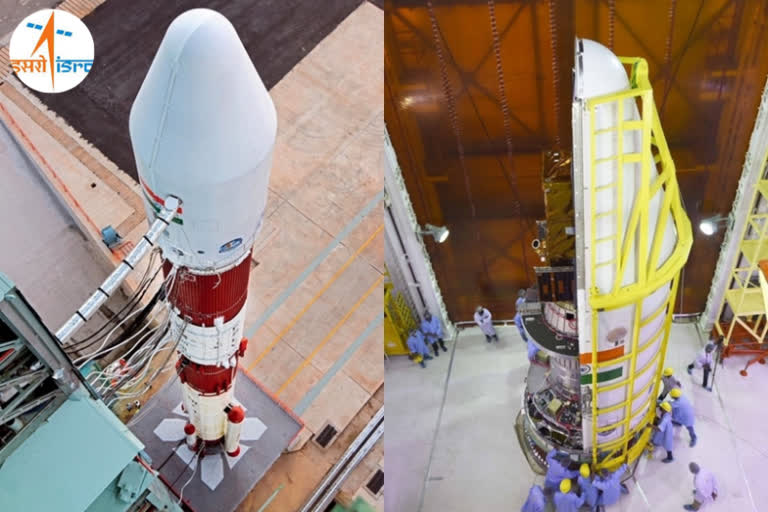Chennai: The countdown for India's one of the longest rocketing by Polar Satellite Launch Vehicle (PSLV) rocket carrying 19 satellites began at 8.54 a.m. on Saturday, said a top official of the Indian Space Research Organisation (ISRO).
The Indian rocket numbered PSLV-C51 carrying the 637-kg Brazilian satellite Amazonia-1 and 18 other satellites (including 13 from the USA) is scheduled to lift-off from the first launch pad at Satish Dhawan Space Centre (SDSC) in Sriharikota in Andhra Pradesh at 10.24 a.m. on Sunday.
"The countdown for the rocket's flight started at 8.54 a.m for the launch at 10.24 a.m tomorrow (Sunday)," K.Sivan, ISRO Chairman told IANS. ISRO also tweeted about it.
-
Countdown for the launch of #PSLVC51/Amazonia-1 mission commenced today at 0854Hrs (IST) from Satish Dhawan Space Centre (SDSC) SHAR, Sriharikota.
— ISRO (@isro) February 27, 2021 " class="align-text-top noRightClick twitterSection" data="
Launch is scheduled tomorrow at 1024 Hrs IST. pic.twitter.com/XRx3isDsGm
">Countdown for the launch of #PSLVC51/Amazonia-1 mission commenced today at 0854Hrs (IST) from Satish Dhawan Space Centre (SDSC) SHAR, Sriharikota.
— ISRO (@isro) February 27, 2021
Launch is scheduled tomorrow at 1024 Hrs IST. pic.twitter.com/XRx3isDsGmCountdown for the launch of #PSLVC51/Amazonia-1 mission commenced today at 0854Hrs (IST) from Satish Dhawan Space Centre (SDSC) SHAR, Sriharikota.
— ISRO (@isro) February 27, 2021
Launch is scheduled tomorrow at 1024 Hrs IST. pic.twitter.com/XRx3isDsGm
India's first space mission for 2021 is one of the longest for a PSLV rocket is expected to conclude 1 hour, 55 minutes and 7 seconds into its flight.
If all goes well with the Sunday morning rocketing of PSLV-C51 then India would have slung a total of 342 foreign satellites, all for a fee.
The rocketing is a fully commercial one of NewSpace India Ltd (NSIL) with the primary passenger being the Amazonia-1 satellite.
Amazonia-1 is the optical earth observation satellite of the National Institute for Space Research (INPE).
This satellite would further strengthen the existing structure by providing remote sensing data to users for monitoring deforestation in the Amazon region and analysis of diversified agriculture across the Brazilian territory, ISRO said.
The 18 co-passenger satellites include four from IN-SPACe (three UNITYsats from a consortium of three Indian academic institutes (Jeppiaar Institute of Technology, Sriperumbudur, G.H.Raisoni College of Engineering, Nagpur and Sri Shakthi Institute of Engineering and Technology, Coimbatore) and one Satish Dhawan Sat from Space Kidz India) and 14 from NSIL.
The other 14 satellites ferried on a commercial basis are SindhuNetra, an Indian technology demonstration satellite and 13 satellites from the USA viz., SAI-1 NanoConnect-2, a technology demonstration satellite and 12 SpaceBees satellites for two way satellite communications and data relay.
For the third time, ISRO will be using the PSLV rocket's DL variant that will have two strap-on booster motors.
This rocket variant was used the first time to put into orbit the Microsat R satellite on January 24, 2019.
The PSLV is a four-stage/engine rocket powered by solid and liquid fuels alternatively with six booster motors strapped on to the first stage to give higher thrust during the initial flight moments.
The PSLV-C51 mission is one of the longest ones.
The 19 satellites will be put into Sun Synchronous Orbit over a duration of 1 hour, 55 minutes and 7 seconds.
During its flight, the rocket's fourth stage engine will be cut off and restarted a couple of times, the first one will be at 16 minutes into its flight.
Seventeen minutes into its flight the rocket will sling the Brazilian satellite Amazonia-1.
Just over one hour into its flight the rocket's engine will be restarted for about nine seconds before it is shut down again.
After 1 hour, 49 minutes and 52 seconds the rocket's engine will be reignited for eight seconds after which the 18 piggyback satellites will be put into orbit.
Also Read: PUBG: New State, New mobile game announced for Android and iOS
(Inputs from IANS)



